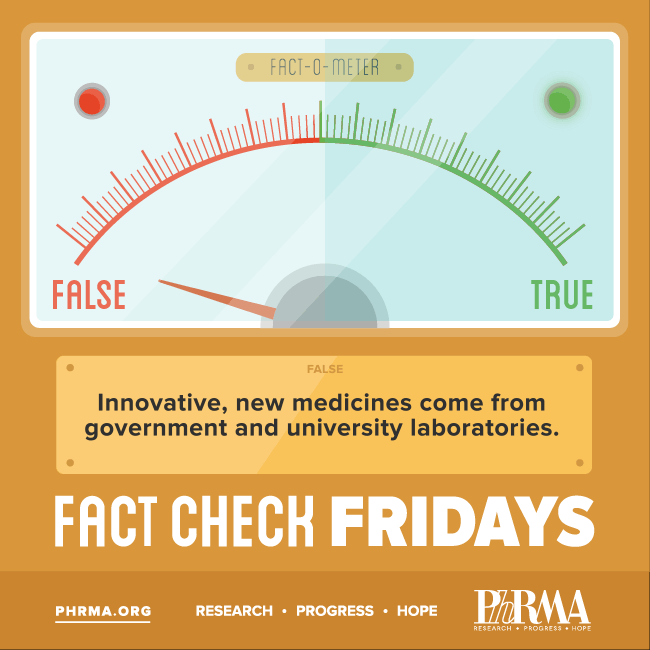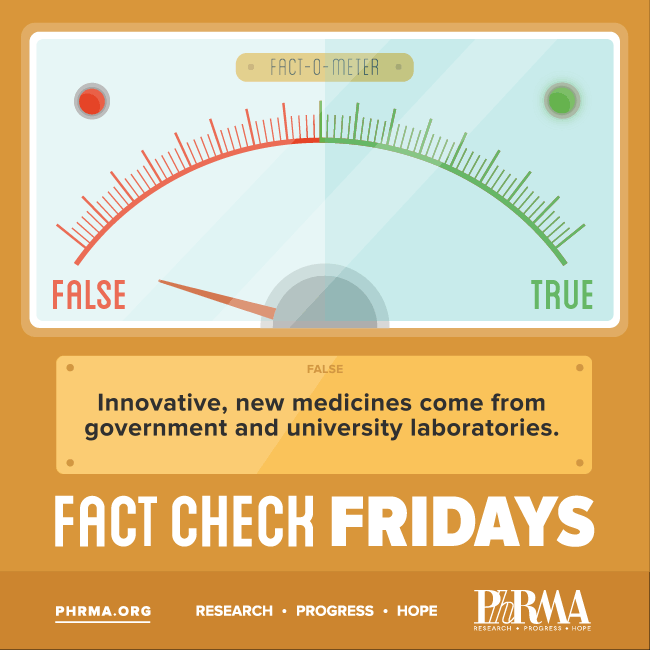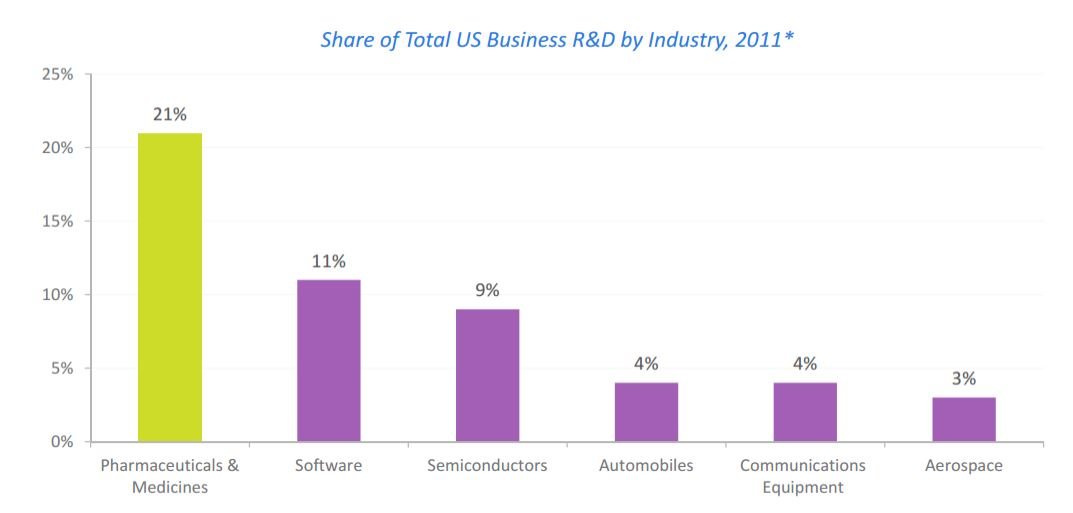Fact Check Friday: The truth about Industry’s role in R&D
MYTH: Innovative, new medicines come from government and university laboratories.

Fact Check Friday: The truth about Industry’s role in R&D.
MYTH: Innovative, new medicines come from government and university laboratories.

Fact Check Friday: The truth about Industry’s role in R&D.
As a follow-up to this blog we posted last year, PhRMA is excited to share new data that provides a fresh look at the significant investment of America’s biopharmaceutical companies make in R&D. In 2015, PhRMA member companies invested an estimated $58.8 billion in research and development (R&D), up 10.3 percent from 2014.
The figure demonstrates that the biopharmaceutical industry invested more on R&D than the entire operating budget of the National Institutes of Health (NIH), which totaled $30.3 billion. This new data reaffirms that while government researchers often initiate important basic science, it is the biopharmaceutical industry providing the necessary resources, expertise and experience to translate complex research into new and innovative medicines for patients in need.

This week on Fact Check Friday, we’re getting to the heart of the biopharmaceutical industry’s investment and role in research and development (R&D) of new medicines.
 MYTH: Innovative, new medicines come from government and university laboratories.
MYTH: Innovative, new medicines come from government and university laboratories.
FACT: America’s biopharmaceutical companies conduct the vast majority of R&D to bring new medicines to patients.
While government research supports basic research, America’s biopharmaceutical companies conduct the critical R&D needed to bring new medicines to patients and bear the associated costs and risks. In fact, the biopharmaceutical sector spends more on R&D than the entire National Institutes of Health operating budget with PhRMA member companies investing $51.2 billion in 2014, and over half a trillion dollars since 2000. This amount represents about one in every five dollars spent on domestic R&D by U.S. businesses. The investment not only fosters medicines through the long and complex development process, but also supports a total of about 3.4 million jobs across the country, including approximately 810,000 direct jobs.
 In a recent white paper from the Tufts University School of Medicine, the authors found that in “two decades of reliable analyses by academia and government, assessed using a variety of methodological approaches, consistently demonstrate that 67 percent to 97 percent of drug development is conducted by the private sector.” The paper went on to say that, “While the basic science underpinning the key disciplines needed to discover and develop drugs is often initiated in academia, it is primarily the biopharmaceutical industry where the crucial disciplines of medicinal chemistry, process chemistry and formulation, drug metabolism and pharmacokinetics, and safety sciences are practiced at a scale and level of integration necessary in order to bring a new medicine to the patients that need them.”
In a recent white paper from the Tufts University School of Medicine, the authors found that in “two decades of reliable analyses by academia and government, assessed using a variety of methodological approaches, consistently demonstrate that 67 percent to 97 percent of drug development is conducted by the private sector.” The paper went on to say that, “While the basic science underpinning the key disciplines needed to discover and develop drugs is often initiated in academia, it is primarily the biopharmaceutical industry where the crucial disciplines of medicinal chemistry, process chemistry and formulation, drug metabolism and pharmacokinetics, and safety sciences are practiced at a scale and level of integration necessary in order to bring a new medicine to the patients that need them.”
As a result of past and current investments, the pipeline of new and innovative medicines has never been more promising and patients are benefitting. Today, 7,000 new medicines are being developed around the world and 70 percent of new medicines in development are potential first-in-class therapies, meaning they use a completely new approach to fighting a disease. And as more and more therapies become tailored to individuals, 42 percent of new medicines in the pipeline have the potential to be personalized medicines.
All of these advancements occur even though biopharmaceutical R&D is an extremely complex process and failures are more common than success. In fact, just 12 percent of drugs entering clinical trials ever make it to patients and thousands won’t even reach past the early discovery and pre-clinical testing stages. Furthermore, to bring one medicine to market alone costs the biopharmaceutical industry on average of $2.6 billion – including failure and often takes 10-15 years.
America’s biopharmaceutical research companies’ sole focus will continue to be developing innovative, lifesaving medicines to help patients live longer, healthier lives. To learn more about the process behind bringing new treatments to patients, visit Innovation.org.